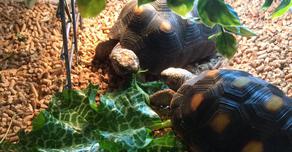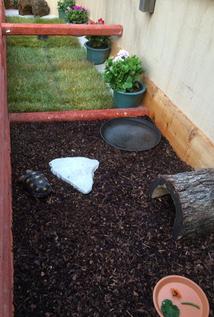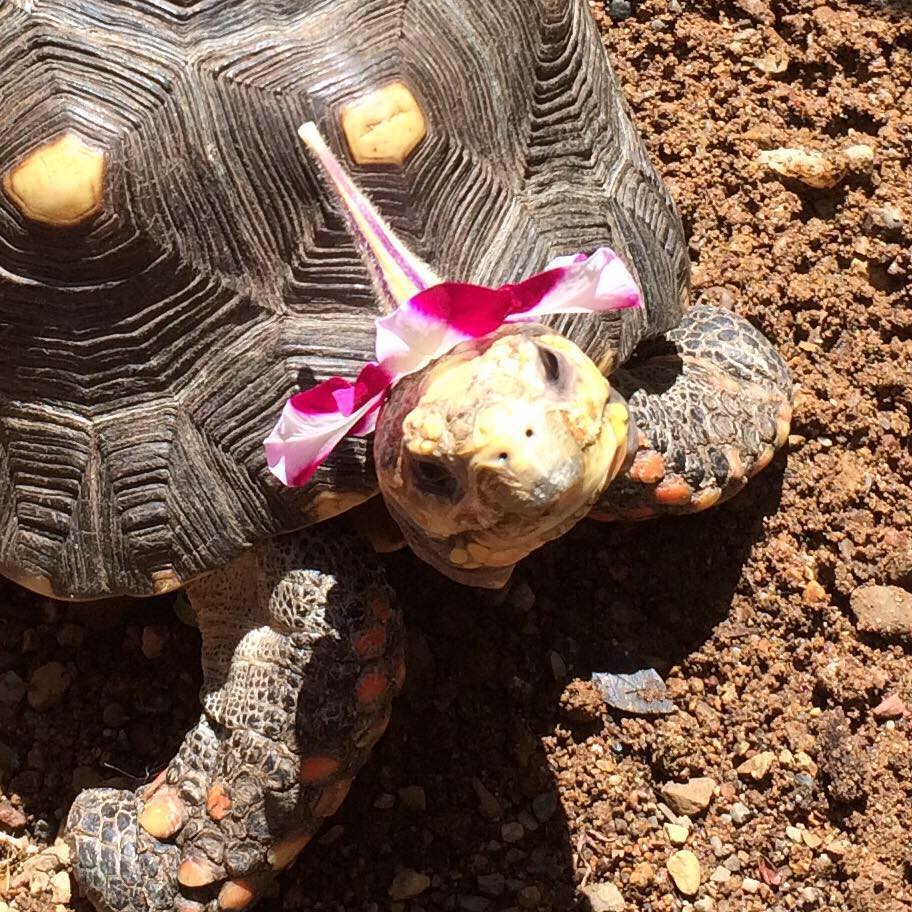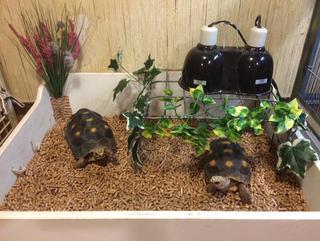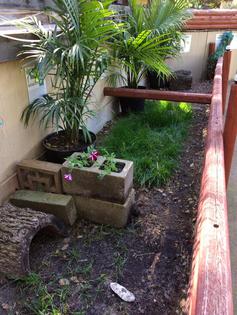Red Footed Care Information
Red Foot, Yellow Foot & Cherry Head tortoises are a very fun tortoise to own. They are very personable and easy to manage at their medium size. They are fun to feed as they eat a wide varty of fruits, vegitables and proteins.
Red-Footed Tortoise Habitat
Red-footed tortoise enclosures require a sturdy wall at least 16 inches in height above ground, as well as a few inches below ground, to prevent (or discourage) these tortoises from digging. Red-footed tortoises aren’t usually burrowing or digging tortoises, so this isn’t as much of a concern as it would be with other tortoise species. See-through fences and walls should not be used, as the tortoises tend to try to escape through or over these walls if they can see the other side.
Many different substrates can be used for indoor red-footed tortoise enclosures. For all sizes of tortoise, cypress mulch has proven to be a great bedding. It’s absorbent, safe and relatively low cost. Other good options include coconut coir or peat moss.
Humidity is very Important for the Red Foot tortoise. The more humid microclimate helps their shells to grow smoothly and helps in keeping the tortoise hydrated. Tortoises raised without proper humidity tend to dehydrate quickly and form “bumpy” shells as they grow. Adding a sprinkler to outdoor enclosures helps mimic the rain forest where they live. Indoor enclosures need a repti fogger.
I also include a few large, flat rocks in the enclosure. They help file down the tortoises’ nails down.
Red-Footed Tortoise Lighting and Temperature
Red-footed tortoises that live outdoors are tolerant to various temperature ranges. High temperatures are generally not going to be a problem provided that the tortoise has a shaded area to escape to if desired and constant access to water to soak in and drink.
Indoors, red-footed tortoises can be maintained at normal room temperatures: 68 to 80 degrees. They should also have a basking area heated by an overhead light or a ceramic heat emitter. This warm spot should be in the 90-degree range. While some don’t think it’s needed, we provide a UVB light in the indoor enclosures to help them properly process the calcium in their diets. When placed overhead, it will not lead to eye damage as is sometimes claimed. Lights should run 12 to 14 hours a day, and a mild heat source can be used 24/7 under or over the hide box area (small heat pads, red bulbs or ceramic heat emitters work great for this). Lamp timers make the light cycle consistent and easy.
Red-footed tortoises exist in a wide variety of habitats in the wild, from grassland to jungle, almost all with moderate to high humidity and moderate temperatures. Red-foots can handle variable amounts of humidity in captivity once grown, but babies should be kept humid to ensure proper smooth shell growth in their first few years. A Repti-Fogger
Red-footed tortoises do not hibernate but will go through a winter slow-down period during cooler weather and shortened day-lengths. As adults, red-footed tortoises can safely handle body temperatures as low as 45 degrees at night as long as they are able to heat up into the 70s during the day. Summer temperatures up to 100 degrees can be tolerated as long as there is a cooler, shaded retreat the tortoise can get into. Moisture is not a problem in warmer temperatures (a cool mudhole on a hot day), but the tortoises should be kept dry on cold nights.
Red-Footed Tortoise Food
Red-footed tortoises are typically eager eaters, rarely turning down a meal. With adult tortoises, we feed them the best mix possible of various fruits, veggies, flowers and leaves. Protein is a natural part of their diet. Crickets, worms and bug are a favorite in Red Foots. They will also graze on mulberry leaves, grape leaves, hibiscus leaves and flowers. They enjoy Mazuri tortoise diet as much as any tortoise does, and having this on hand works well for a backup plan if you can’t get to the store for fresh greens, and it is a good supplemental diet. Mazuri tortoise diet works well to cover any of the nutritional bases that the other diet may have missed.
If you are interested in adding a Red Foot Tortoise to your family go to our Adoption page to see when one is available.
http://www.tortoiseacres.com/Adoptions.html
This page is dedicated to the care of the
Red Foot, Yellow Foot & Cherryhead Tortoise.
This outdoor enclosure has a few different types of substraights in it.
Bark, Grass & Sand.
We added palm trees for more shade.
A nice water dish big enough for soaking is useful. A terra cotta pot for food helps keep the beak trimmed.
Dodi flew in from New York FedEx to live at the sanctuary. She is 21 years old and weighs 15lbs.
Palm trees added for a rain forest effect. This also provides plenty of shade in our hot summer weather.
This is our holding pen when we are cleaning out their enclosures.




